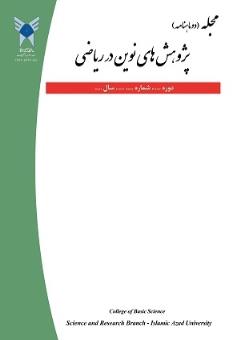مبادلات تولید و محدودیتهای وزنی در تحلیل پوششی دادههای نسبی
محورهای موضوعی : تحقیق در عملیات
1 - گروه ریاضی، واحد شیراز، دانشگاه آزاد اسلامي، شیراز، ايران
کلید واژه: تحلیل پوششی داده ها, آنالیز نسبی, تحلیل پوششی داده های نسبی, محدودیت وزنی, مبادلات تولید.,
چکیده مقاله :
در این مقاله به بررسی موضوع اعمال اطلاعات برتری ارزشی در تحلیل پوششی داده ها در حضور دادههای نسبی میپردازیم. ما نشان میدهیم اعمال محدودیتهای وزنی در مدل آنالیز نسبی معادل در نظر گرفتن مبادلات تولید میان نسبتهای مولفههای ورودی به خروجی در مدل تحلیل پوششی دادههای نسبی میباشد. در ادامه یک مقایسه میان نمره کارایی و رتبه متناظر با واحدهای تصمیمگیرنده حاصل از این دو مدل با انتخاب متفاوت محدودیت های وزنی بر اساس یک مثال کاربردی انجام می دهیم. بدین منظور به ارزیابی عملکرد و رتبه بندی واحدهای دانشگاهی با در نظر گرفتن محدودیت های وزنی براساس نظر مدیران ارشد دانشگاه می پردازیم. ما نشان می دهیم که با انتخاب متفاوت وزنها مقادیر کارایی واحد تغییر می کند و با اعمال محدودیت های وزنی کارایی واحدهای دانشگاهی بهبود نمی یابد. انتخاب مناسب وزنها می تواند یک ارزیابی مناسب براساس نظر مدیر را به همراه داشته باشد. در انتها نتایج حاصل از تحقیق را میآوریم.
In this paper, we will examine the issue of applying superior value information in data envelopment analysis (DEA) in the presence of ratio data. We show that applying weight restrictions in the ratio analysis model is equivalent to considering production trade-offs between the ratios of input to output components in the ratio based data envelopment analysis (DEA-R) model. In the following, we make a comparison between the efficiency score and the corresponding ranking with the decision-making units (DMUs) resulting from these two models with different selection of weight restrictions based on a practical example. For this purpose, we evaluate the performance and ranking of academic units, taking into account the weight restrictions based on the opinion of the senior managers of the university. We show that by choosing different weight restrictions, unit efficiency values change, and by applying weight restrictions, the efficiency scores of university units do not improve. At the end, we bring the results of the research.
[1] Allen R., Athanassopoulos A., Dyson R. G., Thanassoulis E.,1997, Weights restrictions and value judgments in data envelopment analysis: Evolution, development and future directions, Annals of Operations Research 73, 13–34.
[2] Chen W. C., McGinnis, L. F., 2007, Reconciling ratio analysis and DEA as performance assessment tools, European Journal of Operational Research 178, 277–291.
[3] Despic O., Despic M., Paradi J. C., 2007, DEA-R: Ratio-based comparative efficiency model, its mathematical relation to DEA and its use in applications, Journal of Productivity Analysis 28(1), 33–44.
[4] Gerami J., 2019, An interactive procedure to improve estimate of value efficiency in DEA, Expert Systems with Applications 137, 29–45.
[5] Gerami J., Mozaffari M. R., Wanke P.F., 2020, A multi-criteria ratio-based approach for two-stage data envelopment analysis, Expert Systems with Applications 158, 113508.
[6] Gerami J., Mozaffari M.R., Wanke P.F., Correa H., 2022, A novel slacks-based model for efficiency and super-efficiency in DEA-R, Operations Research 22(4), 3373–3410.
[7] Gerami J., Kiani Mavi R., Farzipoor Saen R., Kiani Mavi N., 2023, A novel network DEA-R model for evaluating hospital services supply chain performance. Annals of Operations Research
324, (1-2), 1041-1066.
[8] Mozaffari M. R, Kamyab P., Jablonsky J., Gerami, J., 2014, Cost and revenue efficiency in DEA-R models. Computers & Industrial Engineering 78, 188–194.
[9] Mozaffari M. R, Gerami J., Jablonsky J., 2014, Relationship between DEA models without explicit inputs and DEA-R models, Central European Journal of Operations Research 22(1), 1–12.
[10] Mozaffari M. R., Dadkhah F., Jablonsky J., Wanke, P. W., 2021, Finding efficient surfaces in DEA-R models’, Applied Mathematics and Computation 386, 125497.
[11] Podinovski V.V., 2004, Production trade-offs and weight restrictions in data envelopment analysis. Journal of the Operational Research Society 55(12),1311–1322.
[12] Podinovski V. V. 2007, Computation of efficient targets in DEA models with production trade-offs and weight restrictions, European Journal of Operational Research 181(2), 586–591.
[13] Podinovski V.V., Bouzdine-Chameeva T., 2013, Weight restrictions and free pro-duction in data envelopment analysis, Operations Research 61(2), 426–437.
[14] Podinovski V.V., Bouzdine-Chameeva T., 2015, Consistent weight restrictions in data envelopment analysis, European Journal of Operational Research, 244(1), 201-209.
[15] Papaioannou G., Podinovski V.V., 2023, Production technologies with ratio inputs and outputs, European Journal of Operational Research 310, 1164–1178.
[16] Roll Y., Cook W.D., Golany B., 1991, Controlling factor weights in data envelopment analysis. IIE Transactions 23(1), 2–9.
[17] Song M., Wu J., Wang Y., 2011, An extended aggregated ratio analysis in DEA, Journal of Systems Science and Systems Engineering 20(2), 249-256.
[18] Wei C. K., Chen L. C., Li R. K., Tsai C. H. 2011, A study of developing an input
oriented ratio-based comparative efficiency model, Expert Systems with Applications 38(3), 2473–2477.
[19] Wei C. K., Chen L. C., Li R. K., Tsai C. H. 2011, Exploration of efficiency underestimation of CCR model: Based on medical sectors with DEA-R model, Expert Systems with Applications 38(4), 3155–3160.
[20] Wei C. K., Chen L. C., Li R. K., Tsai C. H. 2011, Using DEA-R model in the
hospital industry to study the pseudo-inefficiency problem, Expert Systems with Applications 38(3), 2172–2176.
[21] Wu D. S., Liang L., Huang Z. M., Li S. X., 2005, Aggregated ratio analysis in DEA,
International Journal of Information Technology & Decision Making, 4(3), 369–384.
[22] Zha Y., Liang, L., 2015, Aggregated ratio analysis in DEA, International Journal of Information Technology & Decision Making 14(6), 1285-1297.


